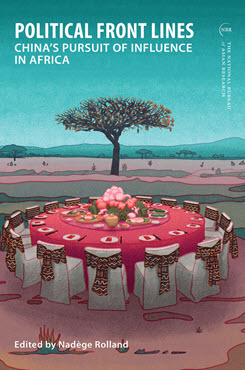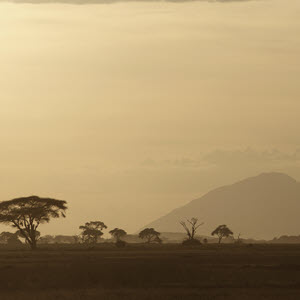Essay from NBR Special Report no. 100
Political Front Lines: China's Pursuit of Influence in Africa
Introduction
This is the introduction to the NBR report “Political Front Lines: China’s Pursuit of Influence in Africa.”
Over the past five years, China’s overseas political influence activities have drawn increasing scrutiny in Western democracies in Oceania, North America, and Europe. Groundbreaking scholarly work by academics, media investigations by journalists, revelations of high-profile cases, and public warnings from intelligence agencies have led several governments to officially express concern over Chinese influence activities and to adopt measures to better defend themselves against unacceptable intrusions into their domestic social and political processes. This collective knowledge production has also allowed greater public awareness on what the Chinese Communist Party (CCP) calls “united front work,” including its tactics, targets, objectives, proxies, and supporting bureaucracies. However, compared with the growing body of literature that is available on Chinese united front activities in advanced liberal democracies, very little attention has been devoted so far to understanding whether and how this sophisticated and sprawling system is deployed in the developing world. This report strives to fill this gap, by focusing specifically on China’s influence efforts in Africa.
As observed in Western democracies, political influence activities can take many forms, from “routine cultural diplomacy to purchasing political favors and silencing critics.”[1] Other noted activities include “securing access to strategic information and resources,”[2] “repurposing” democratic structures as tools serving the CCP’s policies,[3] and “increasing the CCP’s political influence, interfering in the Chinese diaspora, suppressing dissident movements, building a permissive international environment for a takeover of Taiwan, intelligence gathering, encouraging investment in China, and facilitating technology transfer.”[4] The scope of united front work has evolved to keep up with the CCP’s varying priorities, but its main task and basic framework remain unchanged. Put simply, it seeks to form tactical alliances to engineer an environment that is favorable to the advancement of the party-state’s goals, while marginalizing and neutralizing those who may stand in its way. In Xi Jinping’s words, united front is about drawing the broadest possible concentric circle around the party.[5] Accordingly, the CCP “wants to expand united front work to make maximum use of all Chinese talent, both domestic and among the Chinese diaspora as well as from any others who might be willing to assist.”[6] Managing overseas Chinese communities, co-opting foreigners, and influencing the perception of wider audiences are equally important to achieve the broadening of the CCP’s supporting circle.[7] As Mareike Ohlberg explains in the opening essay of this report, the same basic framework is applied throughout Africa, where united front organizations and tactics are deployed to serve the CCP’s strategic objectives both at the global and local levels. Her meticulous description of united front organizations active in Africa sheds a unique light on their characteristics, targets, tactics, and objectives.
As is true in other parts of the world, the CCP’s efforts to influence African countries begins with local ethnic Chinese communities. According to some estimates, the number of Chinese living in African countries increased from 136,000 in 1996 to 1.1 million in 2012.[8] Overseas Chinese are currently mainly concentrated in South Africa (approximately 300,000), Angola (approximately 260,000), and Nigeria (approximately 180,000), followed by Mauritius, Madagascar, Ghana, and Tanzania (between 30,000 and 50,000 in each country).[9] Chinese communities now living in Africa are very diverse, whether in terms of their geographic origins (including Guangdong, Zhejiang, Fujian, Jiangsu, Macau, and Taiwan), their settlement date, the duration of their stay, and their profession (miners, railway workers, and slave laborers before the twentieth century; construction workers, medical personnel, teachers, and agricultural technicians in the 1960s; and employees of state-owned enterprises and private entrepreneurs since the mid-1980s).[10] This complexity collides with the CCP’s attempts to create a single Chinese identity under the party’s own authority,[11] as well as with its efforts to speak on behalf of all overseas ethnic Chinese groups.
To several Chinese scholars, overseas Chinese in Africa are important to the local projection of a positive image of China. They act as “spokespersons,” perception “shapers,” “friendship messengers,” and “loyal inheritors and promoters of Chinese traditional culture” in their host country.[12] They can also play the role of crucial “bridges” to facilitate the constructive development of China-Africa relations. They have useful political and business contacts and understand the local political and economic environment,[13] while at the same time being “familiar with China’s political and economic system, policy preferences, and diplomatic style.”[14] Therefore, their “advice and suggestions to local government departments can, to a certain extent, influence the behavior and policies of their host countries toward China.”[15]
These advantages are well known to the CCP’s united front bureaucracy, which actively uses some overseas Chinese as conduits and connectors between mothership organizations in China and local actors in Africa. In July 2015, 41 leaders from 30 united front associations present in 21 African countries participated in a week-long training seminar jointly organized by the State Council’s Overseas Chinese Affairs Office (absorbed by the United Front Work Department in 2018) and the Huaqiao (Overseas Chinese) University. Participants learned how to contribute to the China-Africa exchanges, “tell the China story well,” and become “ambassadors” of Sino- African friendship.[16]
In addition to ethnic Chinese living in African countries, China’s united front system also targets local political elites. To cultivate influence within these circles, the CCP relies partly on historical legacies, partly on a combination of economic leverage and structured programs directed at specific stakeholders strategically chosen within host countries. The deepening of party-to- party relations under the helm of the CCP’s International Liaison Department offers a concrete illustration of how such programs are structured and deployed to achieve desired outcomes. The cumulated visits, study tours, seminars, and political training programs provide the CCP with a “convenient mechanism to reach out to the local political elites to influence and sometimes ‘capture’ them,” notes Jean-Pierre Cabestan in his essay. The network the CCP is able to nurture through such activities has no equivalent in the world. Although party-to-party relations have not led to the triumph of the CCP’s ideological influence over liberal democratic values in African countries, they have certainly helped China “neutralize any open criticism, let alone opposition, in Africa to its own rule.” Paul Nantulya’s contribution examines similar activities that target another specific group within local bureaucracies: African police and law enforcement. China’s Ministry of Public Security is developing capacity-building and training programs that over time will help China in both protecting its security interests and positioning itself as a security partner of choice for African countries. Nantulya notes that China’s cultivation of African public security actors has already been successful in “fostering a common language of security by promoting the uptake of shared norms and practices.” The enduring nature of China’s legal cooperation mechanisms in Africa, critically important for its law-enforcement activities, lays the foundation for deepened normative convergence and alignment with Beijing’s security interests.
When nurturing political elites, China’s united front system seeks to influence African policymakers’ decisions in a direction that is favorable to Beijing’s interests and preferences. Beijing hopes to obtain specific outcomes, which may include voting support in international institutions or the signing of agreements related to the Belt and Road Initiative. China’s influence efforts do not stop at the door of local political personalities but also target African intellectual elites, and through them wider public opinion. Through increased engagement with African educational institutions, research centers, and media outlets, the CCP’s propaganda and united front system seeks both to disseminate China’s positive image and to counter what Chinese public relations officials often call the Western “demonization” of China.
Shaping African perceptions of China is key not only to gaining trust and enhancing moral prestige but also to projecting China’s model as a source of “inspiration” for Africa.[17] This is not an easy task, especially as Western media outlets still retain considerable influence over the diffusion of information in French and English. Some Chinese experts recommend strengthening China’s presence in African mainstream media, because readers “tend to be more educated” and belong to political and economic elites that have “the ability to lead opinions.” They also advise developing a presence in social media to specifically shape the perception of African youth.[18] Emmanuel Dogbevi describes how these methods are deployed concretely in a well-planned, multipronged approach toward Ghana’s media. Major Chinese state actors broadcast directly into the country, partner with existing local media organizations, sponsor training programs in China for media workers, and grant scholarships to study journalism at Chinese universities. The testimonies of Ghanaian journalists that Dogbevi collected for his essay illustrate the far-reaching impact of these programs on the recipients’ perceptions, which is subsequently reflected in China-related news reports to Ghanaian audiences.
In the final essay, Adam George identifies all the main strands discussed in the other contributions to this report as he examines the drivers of China’s influence in Kenya and Tanzania. The consolidation of China’s grip on both countries’ political and social elites creates leverage that “facilitate[s] economic and political goals at the regional and national levels.” In pursuit of its preferred policy outcomes, the party-state has deployed wide-ranging tactics to cultivate political influence and increase positive perceptions. Economic incentives and the proactive cultivation of leading figures of both countries’ ruling parties, coinciding with an increased local dissatisfaction with the West’s emphasis on democratic values, are shaping a local landscape that is more amenable to incorporating elements of the “China model” of governance. George suggests that China may use Kenya and Tanzania as templates for its pursuit of influence in other countries in Africa and the “global South.”
This report constitutes a preliminary study of a complex phenomenon that deserves closer attention. There is a great deal of consistency between united front activities in Africa and in Western democracies. However, the five essays point to a possible significant difference, not in means but in ends. In developed countries, a sizeable portion of united front work is meant to gain access to scientific knowledge and advanced technologies, in particular to support China’s military modernization needs.[19] In Africa, China’s united front work does not seem to be as much about extracting strategic knowledge transfers as it is about spreading Beijing’s governance model. Over the long term, the cumulative effect of China’s assiduous influence efforts, training programs, elite capture, and information control may not only translate into official African support for Beijing’s policies but also enable the incremental transformation of Africa’s political landscape in ways that reflect the principles and preferences of the CCP regime. Such an outcome is far from preordained, however—in part because African governments and societies are not idle bystanders waiting to be modeled according to the CCP’s vision.
Nadège Rolland is Senior Fellow for Political and Security Affairs at the National Bureau of Asian Research.
Endnotes
[1] John Fitzgerald, “China in Xi’s ‘New Era’: Overstepping Down Under,” Journal of Democracy 29, no. 2 (2018): 59–67.
[2] Anne-Marie Brady, “China in Xi’s ‘New Era’: New Zealand and the CCP’s ‘Magic Weapons,’” Journal of Democracy 29, no. 2 (2018): 68–75.
[3] Jichang Lulu, “Repurposing Democracy: The European Parliament China Friendship Cluster,” Sinopsis, November 26, 2019, https://sinopsis. cz/wp-content/uploads/2019/11/ep.pdf.
[4] Alex Joske, “The Party Speaks for You: Foreign Interference and the Chinese Communist Party’s United Front System,” Australian Strategic Policy Institute (ASPI), Policy Brief, no. 23, June 2020.
[5] “Tongyizhanxian wu xiao shi, Xi Jinping bai hua zuida tongxin yuan” [United Front Is No Small Matter, Xi Jinping Delineates Broadest Concentric Circle], China News, May 18, 2018, https://www.chinanews.com.cn/gn/2018/05-18/8516917.shtml.
[6] Gerry Groot, “The CCP’s Grand United Front Abroad,” Sinopsis, September 24, 2019.
[7] Anne-Marie Brady, “Magic Weapons: China’s Political Influence Activities under Xi Jinping,” Wilson Center, September 2017.
[8] Li Anshan, “Zhanhou Feizhou Zhongguo yimin renkou zhuangkuang de dongtai fenxi” [A Dynamic Analysis of the Situation of Postwar Chinese Emigration to Africa], Guoji Zhengzhi Yanjiu, no. 6 (2017): 24–25.
[9] Ibid., 9–42; and Zhou Haijin, “Feizhou Huaqiao Huaren shengcun zhuangkuang ji qi yu dangdi zuqun guanxi” [Living Conditions of Overseas Chinese in Africa and Their Relationships with Local Ethnic Groups], Dongnanya Yanjiu, no. 1 (2014): 79–84.
[10] Yoon Jung Park, “Chinese Migration in Africa,” South African Institute of International Affairs, Occasional Paper, no. 24, 2009; and Zhou, “Feizhou Huaqiao Huaren shengcun zhuangkuang ji qi yu dangdi zuqun guanxi.”
[11] Obert Hodzi, “Chinese in Africa: ‘Chineseness’ and the Complexities of Identities,” Asian Ethnicity 20, no. 1 (2019): 1–7.
[12] Zhang Mengying, “Feizhou Huaqiao Huaren xingxiang de lishi yanbian yu tisheng” [Historical Evolution and Upgrading of the Image of Overseas Chinese in Africa], Journal of Shaanxi Normal University 48, no. 6 (2019): 63–71; and Huang Zhichun, “Shi xi Feizhou Huaqiao Huaren zai ‘Yidai Yilu’ changyi tuijin zhong de zuoyong” [A Tentative Analysis of the Role of Overseas Chinese in Africa in Promoting the Belt and Road Initiative], Journal of the Sichuan Institute of Socialism, no. 3 (2020): 92–96.
[13] Huang Rihan, “Feizhou Huaqiao Huaren zhuli ‘Yidai Yilu’ jianshe” [Overseas Chinese in Africa Help Belt and Road Construction], People’s Daily, March 9, 2017, http://world.people.com.cn/n1/2017/0309/c14549-29134306.html.
[14] Huang, “Shi xi Feizhou Huaqiao Huaren zai ‘Yidai Yilu’ changyi tuijin zhong de zuoyong.”
[16] “Di 33 qi Huaqiao Huaren shetuan fuzeren yanxiban jieye” [Completion of 33rd Study Session for Leaders of Overseas Chinese Associations], Huaqiao University, July 15, 2015, https://cir.hqu.edu.cn/info/1074/1340.htm.
[17] Yuan Wu, “Zhongguo dui Feizhou ruanshili waijiao chutan” [A Preliminary Study of China’s Soft Power in Africa], Xiya Feizhou, no. 5 (2013): 147–60.
[18] Li Hongfeng, “Zhongguo guojia xingxiang zai Feizhou de goujian yu chuanbo: Tiaozhan yu yingdui” [Construction and Dissemination of China’s National Image in Africa: Challenges and Responses], International Communications, March 2021, 27–31.
[19] Alex Joske, “Picking Flowers, Making Honey,” ASPI, October 30, 2018, https://www.aspi.org.au/report/picking-flowers-making-honey.



 Into Africa: China's Emerging Strategy
Into Africa: China's Emerging Strategy
